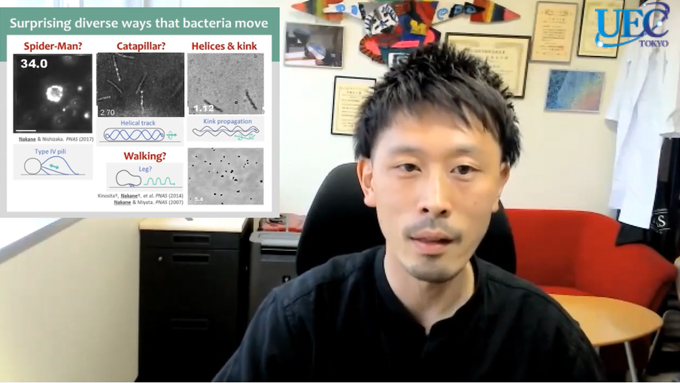June 2021 Issue
Researcher Video Profiles
Daisuke Nakane, Assistant Professor, Department of Engineering Science, UEC Tokyo.
How and why do bacteria move?

Here, Daisuke Nakane describes his research interests and recent results on how and why bacteria move.
It is well known that bacteria are one of the simplest forms of life on Earth. They live everywhere, and have a great impact on our lives, including health, agriculture, and environment.
“Bacteria are too small to be seen directly,” says Nakane. “My research is focused on visualizing bacterial cells and their biological motion using optical microscopy to understand their behavior on a molecular level.”
The molecular systems of bacterial cell motility are completely different from that of humans because they are based on eukaryotic motor proteins such as myosin, kinesin, and dynein.
Some examples in the video show swimming motility driven by rotating flagellar filaments as propellers. This is one of the most famous and well-studied forms of molecular machinery. The flagellar filament is only 20 nm in diameter and rotates at 50 Hz in this species.
Nakane has visualized its rotation with high spatiotemporal resolution with optical microscopes. This had led to new scientific discoveries, such as the observation that some bacteria exhibit a new swimming style of flagella wrapping. When the flagellar filaments switch their rotation towards the other side, the cell wraps the filaments around their bodies and moves like a drilling tank.
More examples include a bacterial Spider-Man, caterpillars, helices and kinks, and walking bacteria with legs.
“Research on bacteria motility over the last 20 years has shown that they exhibit a surprisingly diverse range of movements,” explains Nakane. “This dynamic behavior was observed mainly under laboratory conditions. We do not actually know to what degree these movements contribute to their survival in real environments. I think that the next challenge is to answer the question as to why bacteria move.”
Nakane’s recent work includes observations of the collective motion of bacteria. Experiments of bacterial surface movement in Petri dishes showed bacteria to move in striking patterns of vortices that rotate only in the counterclockwise direction. Given that this is triggered by starvation, the vortex pattern might be a new strategy by bacteria to find nutrients for their survival. Details about this research are given in the Journal of Bacteriology [1].
“You can even see microbes even in a Zoom meeting by using with a smart phone,” demonstrates Nakane in the video using a small chamber containing thousands of microbes. “When I put a drop of water on the camera, it turns into a microscope, and enables us to visualize the individual cell behavior directly. My lab has is new being established in October 2020. I look forward to collaborating with researchers in many other fields. Let’s enjoy science together.”
Keywords of Daisuke Nakane’s research are biophysics, microbiology, and optical microscopy.


